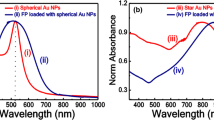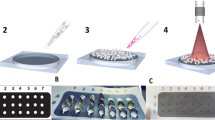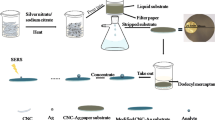Abstract
This paper describes a rapid method for fabrication of a paper substrate coated with gold nanoparticles (GNPs) that results in the formation of a large number of hot spots on the surface and allows an adequate control of the active area. The resulting substrate is shown to be a viable material for use in quantitative surface-enhanced Raman spectroscopy (SERS) analysis. The influence of the amount of GNPs on the SERS signals (using crystal violet as a sample analyte) was correlated with field-emission scanning electron microscopy, UV-visible and theoretical studies. The use of this substrates results in larger enhancement of Raman signals and in comparably repeatability when compared to commercially available substrates. The substrate was applied to SERS-based determination of nicotine and uric acid in aqueous solution, and the respective limits of detection are 20 and 30 μg L−1. The results indicate that the SERS substrates may be applied to the quantification of a wide variety of molecules.

A novel and rapid procedure for preparation of sensitive and reproducible paper-based SERS substrates has been successfully developed and applied to quantitative detection of nicotine and uric acid.







Similar content being viewed by others
References
Etchegoin PG, Ru ECL (2010) Basic electromagnetic theory of SERS. In: Schlücker S (ed) surface enhanced Raman spectroscopy: analitical, biophysical and life science applications. Weinheim, Germany, pp. 1–37
Kneipp J, Kneipp H, Kneipp K (2008) SERS–a single-molecule and nanoscale tool for bioanalytics. Chem Soc Rev 37:1052–1060
Mungroo NA, Oliveira G, Neethirajan S (2016) SERS based point-of-care detection of food-borne pathogens. Microchim Acta 183:697–707
Zhou H, Lin S, Nie Y, et al. (2015) Surface-enhanced resonance Raman scattering (SERRS) simulates PCR for sensitive DNA detection. Analyst 140:7518–7521
Pan Y, Guo X, Zhu J, et al. (2015) A new SERS substrate based on silver nanoparticle functionalized polymethacrylate monoliths in a capillary, and it application to the trace determination of pesticides. Microchim Acta 182:1775–1782
Ma P, Liang F, Wang D, et al. (2014) Ultrasensitive determination of formaldehyde in environmental waters and food samples after derivatization and using silver nanoparticle assisted SERS. Microchim Acta 182:863–869
Bu Y, Lee SW (2015) Flower-like gold nanostructures electrodeposited on indium tin oxide (ITO) glass as a SERS-active substrate for sensing dopamine. Microchim Acta 182:1313–1321
Fan M, Andrade GFS, Brolo AG (2011) A review on the fabrication of substrates for surface enhanced Raman spectroscopy and their applications in analytical chemistry. Anal Chim Acta 693:7–25
Freeman RG, Grabar KC, Allison KJ, et al. (1995) Self-assembled metal colloid monolayers: an approach to SERS substrates. Science 267:1629–1632
Haddada MB, Blanchard J, Casale S, et al. (2013) Optimizing the immobilization of gold nanoparticles on functionalized silicon surfaces: amine- vs thiol-terminated silane. Gold Bull 46:335–341
Cintra S, Abdelsalam ME, Bartlett PN, et al. (2006) Sculpted substrates for SERS. Faraday Discuss 132:191–199
Min Q, Santos MJL, Girotto EM, et al. (2008) Localized Raman enhancement from a double-hole nanostructure in a metal film. J Phys Chem C 112:15098–15101
Hatab NAA, Oran JM, Sepaniak MJ (2008) Surface-enhanced Raman spectroscopy substrates created via electron beam lithography and nanotransfer printing. ACS Nano 2:377–385
Polavarapu L, Liz-Marzán LM (2013) Towards low-cost flexible substrates for nanoplasmonic sensing. Phys Chem Chem Phys 15:5288–5300
Liu H, Crooks RM (2011) Three-dimensional paper microfluidic devices assembled using the principles of origami. J Am Chem Soc 133:17564–17566
Tao H, Chieffo LR, Brenckle MA, et al. (2011) Metamaterials on paper as a sensing platform. Adv Mater 23:3197–3201
Ngo YH, Li D, Simon GP, Garnier G (2012) Gold nanoparticle-paper as a three-dimensional surface enhanced Raman scattering substrate. Langmuir 28:8782–8790
Zhu Y, Zhang L, Yang L (2015) Designing of the functional paper-based surface-enhanced Raman spectroscopy substrates for colorants detection. Mater Res Bull 63:199–204
Zhu Y, Li M, Yu D, Yang L (2014) A novel paper rag as “D-SERS” substrate for detection of pesticide residues at various peels. Talanta 128:117–124
Hasi WLJ, Lin X, Lou XT, et al. (2015) Chloride ion-assisted self-assembly of silver nanoparticles on filter paper as SERS substrate. Appl Phys A Mater Sci Process 118:799–807
Ngo YH, Li D, Simon GP, Garnier G (2013) Effect of cationic polyacrylamides on the aggregation and SERS performance of gold nanoparticles-treated paper. J Colloid Interface Sci 392:237–246
Turkevich J, Stevenson PC, Hillier J (1951) A study of the nucleation and growth processes in the synthesis of colloidal gold. Discuss Faraday Soc 11:55–75
Alexander TA, Le DM (2007) Characterization of a commercialized SERS-active substrate and its application to the identification of intact bacillus endospores. Appl Opt 46:3878–3890
Ringler M, Schwemer A, Wunderlich M, et al. (2008) Shaping emission spectra of fluorescent molecules with single plasmonic nanoresonators. Phys Rev Lett 100:1–4
Xu Y (1995) Electromagnetic scattering by an aggregate of spheres. Appl Opt 34:4573–4588
Johnson PB, Christry RW (1972) Optical constants of the Noble metals. Phys Rev B 6:4370–4379
Patungwasa W, Hodak JH (2008) pH tunable morphology of the gold nanoparticles produced by citrate reduction. Mater Chem Phys 108:45–54
Cañamares MV, Chenal C, Birke RL, Lombardi JR (2008) DFT, SERS, and single-molecule SERS of crystal violet. J Phys Chem C 112:20295–20300
Harraz FA, Ismail AA, Bouzid H, et al. (2015) Surface-enhanced Raman scattering (SERS)-active substrates from silver plated-porous silicon for detection of crystal violet. Appl Surf Sci 331:241–247
Gardner DJ, Oporto GS, Mills R, Azizi Samir MAS (2008) Adhesion and surface issues in cellulose and nanocellulose. J Adhes Sci Technol 22:545–567
Ru EL, Etchegoin PG (2009) Principles of surface enhanced Raman spectroscopy and related plasmonic effects. Elsevier, Amsterdam
Deegan RD, Bakajin O, Dupont TF, et al. (1997) Capillary flow as the cause of ring stains from dried liquid drops. Nature 389:827–829
Carty DM, Delles C, Dominiczak AF (2008) Novel biomarkers for predicting preeclampsia. Trends Cardiovasc Med 18:186–194
Doctor PB, Gokani VN, Kulkarni PK, et al. (2004) Determination of nicotine and cotinine in tobacco harvesters’ urine by solid-phase extraction and liquid chromatography. J Chromatogr B 802:323–328
Jen JF, Hsiao SL, Liu KH (2002) Simultaneous determination of uric acid and creatinine in urine by an eco-friendly solvent-free high performance liquid chromatographic method. Talanta 58:711–717
Acknowledgments
The authors gratefully acknowledge the Conselho Nacional de Desenvolvimento Científico e Tecnológico (CNPq) for financial support.
Author information
Authors and Affiliations
Corresponding author
Ethics declarations
Conflict of interest
The authors declare that there are no conflicts of interest.
Electronic supplementary material
ESM 1
(DOC 5354 kb)
Rights and permissions
About this article
Cite this article
Villa, J.E.L., Santos, D.P.d. & Poppi, R.J. Fabrication of gold nanoparticle-coated paper and its use as a sensitive substrate for quantitative SERS analysis. Microchim Acta 183, 2745–2752 (2016). https://doi.org/10.1007/s00604-016-1918-0
Received:
Accepted:
Published:
Issue Date:
DOI: https://doi.org/10.1007/s00604-016-1918-0




